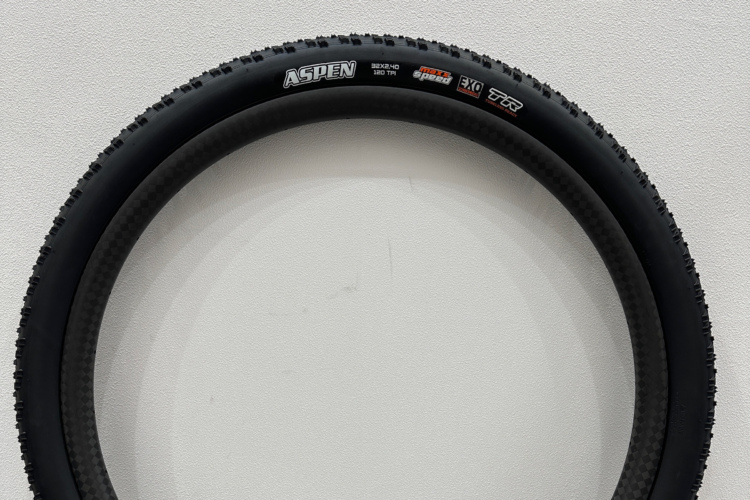
When our 15-year-old Subaru died on a summer road trip last year we decided it was a good time to go electric. I hate car repairs and paying for gas so the promise of lower maintenance and cheaper operating costs were both big selling points. Long story short, we ended up choosing a Volkswagen ID.4, in part because Subaru didn’t have the Solterra yet.
After driving the ID.4 for over a year I seemed to notice a significant decline in my range whenever I had a bike rack and bikes attached. A friend mentioned he also found the range on his EV, a Tesla Model Y, declined noticeably with bikes on board. And at least one Singletracks reader messaged us asking how much a bike rack affects EV range. So naturally I had to run a test to see just how much a bike rack really does affect range and mileage for an EV, and perhaps gas vehicles as well.
The test and setup
I chose to measure a 31-mile roundtrip to my local trail system, Southside Park, since it’s a pretty typical MTB destination for me, and also because the drive includes a good mix of both city and highway driving. As a control I drove to the park and back with my mountain bike inside the car, with no rack attached, to keep the overall weight roughly the same. I also tested attaching the bike to the top of the car with a roof tray, a single bike on a tire-touch-style hitch rack, and two bikes on the same hitch rack.
Read more: Inno Tire Hold Bike Hitch Rack [Review]

If you own an EV or have done some research you know there are MANY factors that affect range: ambient air temperature, speed, the amount of climbing/descending, traffic conditions, and battery charge state, not to mention aerodynamics, which I was attempting to isolate and test. To minimize some of the variation I ran back-to-back tests on the same route at the same time of day over two days.
- Identical route, 31-mile round trip
- Time of day: 8a-11a
- Temperature range: 75-82°F
- Starting charge state for first test of the day: 79%
- +176ft difference between the elevation at the start and the elevation of the park
- Average trip speed: 33-45mph. This was the most difficult to control due to traffic conditions.
- Round trip time: 0:42-0:56 (see previous bullet)
- Regenerative braking mode, climate control at 76° for all tests
Volkswagen ID.4 stats
The 2021 Volkswagen ID.4 Pro S comes with a 82kWh (gross) battery and weighs 2,630kg. Volkswagen reports the vehicle has a range of 250 miles on a full, 100% charge which translates to 3.05 mi/kWh mileage. Put another way, the vehicle is reported to use 35 kWh of energy to go 100 miles, which yields a slightly lower mileage rate, 2.86 mi/kWh. All of these numbers are important as we get into the math later.

To maximize range, and minimize the weight and expense of the battery, electric vehicles favor an aerodynamic shape. According to the internet my old Subaru had a 0.38 drag coefficient; the 2021 Volkswagen ID.4 is said to be 0.28, where a lower number means more aerodynamic. As another point of comparison, my friend’s Tesla Model Y has a 0.23 drag coefficient. Obviously a lot of thought goes into making EVs as aerodynamic as possible, and in theory adding a bike rack will increase the drag coefficient and decrease the range and mileage.
Bike rack affect on EV range
| No rack, bike inside | Roof rack, 1 bike | Hitch rack, 1 bike | Hitch rack, test 2 | Hitch rack, 2 bikes | |
| Start battery % | 79% | 67% | 52% | 79% | 68% |
| Start range | * | 188 | 139 | 213 | 181 |
| Mid battery % | 73% | 60% | 46% | 75% | 62% |
| Mid range | * | 165 | 124 | 201 | 166 |
| Mid mi/kWh | 3.6 | 3.3 | 3.5 | 3.9 | 3.6 |
| Mid avg speed | 39 | 36 | 46 | 40 | 44 |
| Mid time | 0:23 | 0:25 | 0:19 | 0:23 | 0:21 |
| End battery % | 67% | 53% | 38% | 68% | 55% |
| End range | 182 | 145 | 102 | 182 | 145 |
| End mi/kWh | 3.5 | 3.3 | 3.2 | 3.5 | 3.4 |
| End avg speed | 38 | 37 | 45 | 40 | 33 |
| End time | 0:49 | 0:50 | 0:42 | 0:46 | 0:56 |
In the control test my vehicle reported getting 3.6 mi/kWh on the way to the trail, and 3.4 mi/kWh on the return, for an average of 3.5 mi/kWh. (Remember, the trailhead is 176ft lower than my start point.) That’s significantly better than the 3.05 mi/kWh that’s officially reported by Volkswagen, perhaps in an attempt to make up for past sins by under-promising and over-delivering.

Next, I strapped my bike on top of the car using a roof rack tray attached to a set of aftermarket aerobars I purchased online. This time the ID.4 reported 3.3 mi/kWh on the way there and on the way back, which translates into a roughly 6% decrease in efficiency compared to the control. More shockingly, the calculated range dropped 43 miles from start to finish despite the actual trip only being 31 miles long. That is a 39% difference, and more than enough to induce range anxiety in anyone driving an EV.
With the hitch rack and a single bike I got much better mileage on the trip to the trailhead: 3.5 mi/kWh, just 0.1 mi/kWh less than the control. However the trip back was much worse: 2.9 mi/kWh. Since this followed the roof rack test the ID.4 estimated range more accurately, calculating that I burned 37 miles of range for the 31 mile trip. Still, seeing the vehicle range dropping faster than you’re clocking miles is never a good feeling.

Looking at my average speed across these three tests I noticed the first two were very similar (38mph and 37mph, respectively) while the third test was much faster, 45mph. I didn’t feel like I was driving that much faster, but clearly traffic conditions had changed significantly by the third test drive. EV efficiency and range drops off as speeds increase, so this had the potential to really impact my test result.
I decided to try the hitch rack the following day under more similar conditions to the control test. Starting with the same level of charge (79%), at a similar temperature, and at a 40mph average speed for the first half of the test (vs. 39mph in the control), I actually got much better mileage with a hitch rack than the control test: 3.9 mi/kWh vs. 3.6 mi/kWh. For the overall trip the ID.4 reported 3.5 mi/kWh, same as the control, but given the mileage going, this meant the return trip was at 3.1 mi/kWh. That’s about what I found in the test on the previous day at a slightly faster speed, and it’s much lower than the control return trip.
So why was the return trip so much worse with the hitch rack than without? The short answer is, I’m not sure. While 176ft of net elevation gain from the trailhead to home doesn’t sound significant, that represents roughly 0.4 kWh of negative potential energy based on the weight of the car, or roughly 1.2 miles of “free” range. That explains why in all of the tests the mileage was better going than returning. While my hitch rack weighs just shy of 50lb, that extra 50lb only translates to 0.01 kWh of potential energy gain/loss, not nearly enough to explain the difference. The direction of the wind on both days could have had an effect, though my return trip goes west, the same direction as the prevailing wind.

Looking at the whole trip, there and back, the second test with the hitch rack ended up yielding exactly the same average mileage as the control test. Based on my own observations over the past year, I figured adding a hitch rack would decrease mileage and range by roughly 20%, and that a roof rack would be even worse. The test results showed nowhere near that much of a difference, so I decided to see if having two bikes on the rack might be more noticeable. After all, most of my trips over the past year involved carrying two bikes, not just one.
Going to the trailhead with two bikes on a hitch rack gave me 3.6 mi/kWh, again the same as the control test. The return trip worked out to 3.2 mi/kWh, on par or slightly better than just a single bike, for a trip average of 3.4 mi/kWh. Again, the result was very similar to the control test, within 3%. On the way to the trailhead my average speed was on par with previous tests, though the return saw a significantly lower average speed due to traffic.
From a qualitative perspective I can say having a hitch rack is certainly noticeable. The suspension feels like it rebounds more than usual with the extra weight and leverage on the rear of the car. And subconsciously I probably drive a bit slower and more smoothly to prevent the bikes from jostling around in my rearview mirror. With the roof rack there’s a noticeable increase in wind noise as well.
So how much does a bike rack affect EV range?
It’s clear that there are many factors that go into EV range for any trip, and based on my tests I’m not sure I was fully able to isolate the aerodynamic affects. Even if I were, wind speed and direction is yet another factor that plays into overall drag resistance, and I wasn’t able to measure that.

One conclusion I can make is that I’m terrible at estimating range, almost as bad as the ID.4 itself. That’s not really a dig on either one of us, again because there are so many factors involved, and those factors are constantly changing throughout the drive. It is safe to say my gut feeling that a bike rack decrease range by 20% is way off. If anything the effect is much smaller, perhaps on the order of 5-10% max. I suspect the bike rack effect on range for gas-powered vehicles is probably similar, and that could make for another fun test in the future.
Range anxiety is real, especially for new EV owners, and one takeaway for me is that the vehicle’s estimated range isn’t the best gauge for understanding the effect of adding a bike rack. In three out of four of my rack tests, the car’s estimated range dropped by at least 16% more than the actual distance traveled (39% in one case), while the mileage efficiency decreased by a much smaller amount (roughly 3-8%). It would seem the car’s estimated range value has a significant factor of safety built in, or it’s based on sort of a worst-case-scenario calculation.

On a trip to ride bikes in the mountains last month, before I had conducted this test, I weighed putting my bike on the hitch rack, or placing it inside the car. It’s only about 85 miles each way so technically I should have had more than enough range to make it there and back without needing to recharge. At least, based on the car’s reported factory range. In the end I opted to drive with the bike inside the car just to be safe.
I guess I probably didn’t need to do that after all.











9 Comments
Sep 7, 2022
Have you tried A Better Route Planner? It does much better at estimating range and you can input a TON of external and car-related factors. For example, you can do a test loop or out and back at your constant highway speed to find your Wh/mi with a bike on a rack, and input that into ABRP and it will give you a more accurate range estimation. ABRP can also do temperature, elevation change, air density, and rolling resistance from snow or precipitation calculations, not to mention you can choose which charging stations you want to be included on your route plan.
Cheers!
Sep 6, 2022
Sep 6, 2022
One additional question (apologies if you shared this and I missed it) - can you share what hitch you went with for the ID.4?
Sep 6, 2022
https://www.etrailer.com/Trailer_Hitch/Draw~Tite/DT84GR.html
The included instructions are good, and I also got some good info from here:
https://www.vwidtalk.com/threads/video-how-to-install-2-tow-hitch-on-your-vw-id-4-pro-pro-s-diy.3295/
Sep 6, 2022
Sep 6, 2022
If your 85 mile 1 way trip was at higher highway speeds then you probably made the right decision by putting your bike inside the car. I'm guessing you might see more like a 10 to 20% reduction inefficiency at highway speeds.
Also, an observation is that my Prius hybrid gets significantly lower gas mileage with a hitch mounted bike rack with bikes on it, especially at highway speeds. On a recent long-distance trip, it got at least 10 miles per gallon lower efficiency, approximately 25% lower than normal.
Sep 6, 2022
Sep 6, 2022
Sep 6, 2022